 W
WChinchilla rats or chinchillones are members of the family Abrocomidae. This family has few members compared to most rodent families, with only nine known living species. They resemble chinchillas in appearance, with a similar soft fur and silvery-grey color, but have a body structure more like a short-tailed rat. They are social, tunnel-dwelling animals, and live in the Andes Mountains of South America. They are probably herbivorous, although this is not clear.
 W
WAntrozoini is a tribe of bats in the subfamily Vespertilioninae of the family Vespertilionidae. It includes at least the pallid bat, Van Gelder's bat, and the fossil Anzanycteris; some classifications also include the genera Rhogeessa and Baeodon.
 W
WThe tree bat is a species of bat in the family Phyllostomidae and the only species in the genus Ardops. It is found in Dominica, Guadeloupe, Martinique, Montserrat, Netherlands Antilles, Saint Lucia, Saba and Saint Vincent and the Grenadines.
 W
WAllen's yellow bat is a species of vesper bat. There is some taxonomic debate surrounding this species, with some authors considering Baeodon a genus rather than a subgenus. It is endemic to Mexico.
 W
WThe blunt-eared bat or Peruvian crevice-dwelling bat is a species of bat in the family Molossidae. It is monotypic within the genus Tomopeas and subfamily Tomopeatinae. It is endemic to Peru, where it is considered critically endangered. It is threatened by habitat loss.
 W
WThe brown flower bat is a species of bat from the family Phyllostomidae. It is native to the island of Hispaniola, present in both Haiti and the Dominican Republic, and Puerto Rico. In most cases, the brown flower bat is recognized as part of the buffy flower bat, and there are two recognized subspecies: Erophylla bombifrons bombifrons and Erophylla bombifrons santacristobalensis.
 W
WCarolliinae is a subfamily of bats.
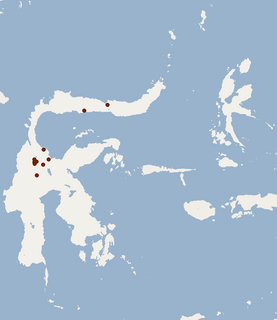 W
WThe central Sulawesi echiothrix is a species of rodent in the family Muridae. It is found only in Sulawesi, Indonesia.
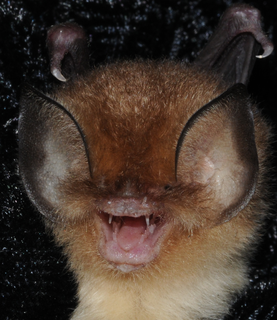 W
WThe genus Chilonatalus of funnel-eared bats is found in South America and the Antilles. It has three species.
 W
WChinchilla rats or chinchillones are members of the family Abrocomidae. This family has few members compared to most rodent families, with only nine known living species. They resemble chinchillas in appearance, with a similar soft fur and silvery-grey color, but have a body structure more like a short-tailed rat. They are social, tunnel-dwelling animals, and live in the Andes Mountains of South America. They are probably herbivorous, although this is not clear.
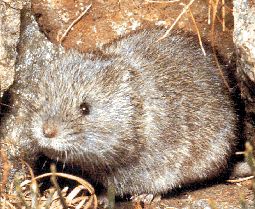 W
WChionomys is a genus of rodent in the family Cricetidae. It contains the following species:Caucasian snow vole European snow vole Robert's snow vole
 W
WThe cinnamon myotis is a species of vesper bat. It is found in Guatemala and Mexico.
 W
WThe common big-eared bat is a bat species from South and Central America. It is a neotropical leaf-nosed bat.
 W
WThe Cuban fruit-eating bat is a species of bat in the family Phyllostomidae found in the Bahamas, Cayman Islands, Cuba, the Dominican Republic, Haiti, Jamaica, and Turks and Caicos Islands.
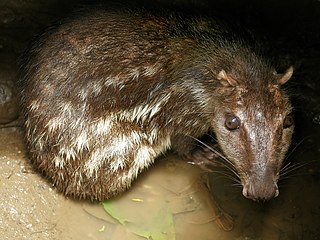 W
WA paca is a member of the genus Cuniculus of ground-dwelling, herbivorous rodents in South and Central America. It is the only genus in the family Cuniculidae. They are large rodents with dots and stripes on their sides, short ears, and barely visible tails. They are also referred to as "gibnuts" or "royal rats".
 W
WThe Curacao myotis is a species of vesper bat . It is found in Bonaire (Netherlands), Colombia, Curaçao and Venezuela.
 W
WThe white-winged vampire bat, a species of vampire bat, is the only member of the genus Diaemus. They are found from Mexico to northern Argentina and are present on the islands of Trinidad and Margarita.
 W
WThe Dominican myotis is a species of vesper bat. It is found in Dominica and Guadeloupe.
 W
WThe elongated shrew is a species of mammal in the family Soricidae. It is endemic to the island of Sulawesi in Indonesia. It lives in the forests of central, northern, and eastern Sulawesi from 200 to 2000 meters elevation.
 W
WErophylla is a genus of bat in the family Phyllostomidae. It contains the following species:Brown flower bat Buffy flower bat
 W
WEumops is a genus of bats in the family Molossidae. A total of 17 species of this genus have been described. The name "Eumops" comes from the Greek prefix "Eu-", meaning "good" or "true," and the Malayan word "mops," which means bat.
 W
WThe Jamaican flower bat is a critically endangered species of bat in the family Phyllostomidae. It is endemic to Jamaica.
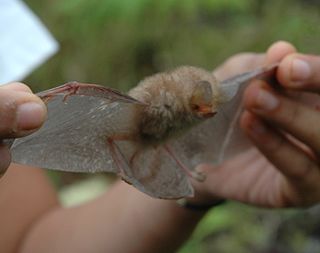 W
WKerivoulinae is a subfamily of vesper bats. There are 25 species in 2 genera within this subfamily:
 W
WThe lesser naked bat is a species of bat in the family Molossidae, the free-tailed bats. It is native to Indonesia and the Philippines.
 W
WThe baiji is a possibly extinct species of freshwater dolphin, and is thought to be the first dolphin species driven to extinction due to the impact of humans. Since Baiji means 'white fin' in Chinese, it means 'white-finned dolphin'. In China, the species is also called the Chinese river dolphin, Yangtze river dolphin, Yangtze dolphin and whitefin dolphin. Nicknamed the "Goddess of the Yangtze", it was regarded as the goddess of protection by local fishermen and boatmen. It is not to be confused with the Chinese white dolphin or the finless porpoise.
 W
WThe little goblin bat is a species of bat in the family Molossidae, the free-tailed bats. It is endemic to Cuba.
 W
WThe Mexican greater funnel-eared bat is a species of bat found in Central America. While initially and currently described as a species, from 1959–2006 it was considered a subspecies of the Mexican funnel-eared bat, Natalus stramineus.
 W
WMiller's long-tongued bat is a bat species from northern South America and the Windward Islands of the Lesser Antilles. It is found in northern Brazil, Venezuela, Colombia, Guyana, Trinidad and Tobago, Grenada, the Netherlands Antilles and the U.S. Virgin Islands.
 W
WThe minute fruit bat (Cynopterus minutus) is a species of megabat within the family Pteropodidae. It is found in Sumatra, Java, Borneo and Sulawesi.
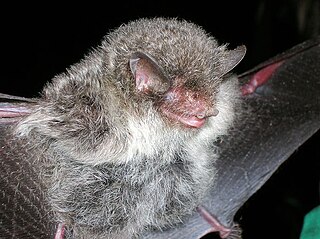 W
WThe Murininae are a subfamily of bats in the family Vespertilionidae. They include the tube-nosed bats and hairy-winged bats in the genera Murina, Harpiola, and Harpiocephalus.
 W
WThe wood lemming is a species of rodents in the family Cricetidae. It belongs to the rodent subfamily Arvicolinae, so is a relative of the voles, lemmings, and muskrats. It is found in the taiga biome of China, Finland, Mongolia, Norway, Russia, and Sweden.
 W
WThe Nicobar flying fox is a species of flying fox in the family Pteropodidae. It is endemic to India. Its natural habitats are subtropical or tropical moist lowland forest and subtropical or tropical swamps. It is threatened by habitat loss due to forest clearing.
 W
WThe Nicobar long-tailed macaque is a subspecies of the crab-eating macaque, endemic to the Nicobar Islands in the Bay of Bengal. This primate is found on three of the Nicobar Islands—Great Nicobar, Little Nicobar and Katchal—in biome regions consisting of tropical and subtropical moist broadleaf forests.
 W
WNomascus is the second-most speciose genus of gibbons. Originally, this genus was a subgenus of Hylobates, and all individuals were considered one species, Hylobates concolor. Species within Nomascus are characterized by 52 chromosomes. Some species are all black, some are light with a distinct black tuft of crown fur, and some have distinct, light-colored cheek patches. Nomascus is found from southern China (Yunnan) to southern Vietnam, and also on Hainan Island. One species, Nomascus nasutus, has been deemed "the most critically endangered ape species in the world". All species in this genus are either endangered or critically endangered.
 W
WNyctinomops is a genus of bats in the family Molossidae.
 W
WThe peninsular myotis is a species of vesper bat. It is endemic to northwestern Mexico, found only within Baja California Sur state on the southern Baja California Peninsula. Its habitats include the southern Peninsular Ranges and deserts.
 W
WThe Philippine dawn bat is a species of megabat in the family Pteropodidae found in the Philippines.
 W
WPhodopus, a genus of rodents in the hamster subfamily Cricetinae—a division of the larger family Cricetidae—is a lineage of small hamsters native to central Asia that display unusual adaptations to extreme temperatures. They are the only known hamsters that live in groups and, in some cases, rely on significant contributions by males to the raising of offspring. They are nocturnal and active throughout the year; they do not hibernate. Species of Phodopus, together with members of the genera Cricetulus, Allocricetulus and Tscherskia are called dwarf hamsters because of their small size relative to other hamsters.
 W
WSquirrel monkeys are New World monkeys of the genus Saimiri. Saimiri is the only genus in the subfamily Saimirinae. The name of the genus is of Tupi origin and was also used as an English name by early researchers.
 W
WSciurotamias is a genus of rodent in the family Sciuridae, found in China. It contains the following species:Père David's rock squirrel Forrest's rock squirrel
 W
WThe slender yellow bat is a species of vesper bat. It is found only in Mexico.
 W
WBlanford's fruit bat is a mountain species of megabat. It is found in several countries in South and Southeast Asia.
 W
WThe Sulawesi forest rat is a species of rodent in the family Muridae. It is found only in central Sulawesi, Indonesia. It is known only from Pinedapa, Poso Pesisir, Poso Regency.
 W
WThe Sulawesi harpy fruit bat is a species of megabat in the family Pteropodidae. It is endemic to Indonesia."This species occurs in Sulawesi, Indonesia. It is also found in Soloi on Buton island in Indonesia. It occurs from sea level up to 2,120m asl or probably higher. This species is not common. In 2002, three individuals were captured at a single locality. Population Trend ↓ Decreasing. It seems to require good forest, but has also been recorded from cocoa plantations. Soloi individuals were caught over a river in undisturbed forest. Roosting habits are not known, but this species is not likely to be a cave dweller. Hunting for sale at market, and forest loss due to expanding agriculture and logging represent major threats to this species. This species is known to occur in Domoga-bone National Park."
 W
WThe Sulawesi montane rat is a species of rodent in the family Muridae. It is found only in central Sulawesi, Indonesia, on Mount Lehio, Mount Kanino, and Mount Nokilalaki.
 W
WThe Sulawesi shrew is a species of mammal in the family Soricidae. It is endemic to the central and northern provinces of Sulawesi in Indonesia. It is a fairly common species and the International Union for Conservation of Nature has assessed its conservation status as being of "least concern".
 W
WThe Sulawesi tiny shrew is a species of mammal in the family Soricidae. It is endemic to the island of Sulawesi in Indonesia.
 W
WThe Sulawesi white-handed shrew or Temboan shrew is a species of mammal in the family Soricidae. It is endemic to the island of Sulawesi in Indonesia. It is a fairly common species and the population seems stable so the International Union for Conservation of Nature has assessed its conservation status as being of "least concern".
 W
WDisk-winged bats are a small group of bats of the family Thyropteridae and genus Thyroptera. They are found in Central and South America, usually in moist tropical rain forests. It is a very small family, consisting of a single genus with five extant and one fossil species.
 W
WThe tiny yellow bat is a species of vesper bat. It is found in Colombia and Venezuela.
 W
WThe blunt-eared bat or Peruvian crevice-dwelling bat is a species of bat in the family Molossidae. It is monotypic within the genus Tomopeas and subfamily Tomopeatinae. It is endemic to Peru, where it is considered critically endangered. It is threatened by habitat loss.
 W
WThe blunt-eared bat or Peruvian crevice-dwelling bat is a species of bat in the family Molossidae. It is monotypic within the genus Tomopeas and subfamily Tomopeatinae. It is endemic to Peru, where it is considered critically endangered. It is threatened by habitat loss.
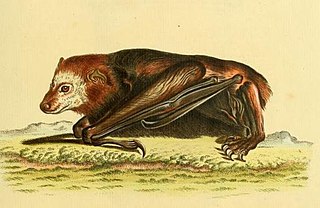 W
WThe Trinidad dog-like bat is a species of bat from the family Emballonuridae. It is native to Aruba, French Guinea, Grenada, Trinidad and Tobago, and Venezuela. The bat is considered to be rare everywhere in its geographic range, although this may be untrue, as the Trinidad dog-like bat was previously confused with the lesser dog-like bat. It is an aerial insectivore that roosts in hollow trees, hollow rotten logs on the ground, under overhanging banks, and caves in the Llanos of Venezuela.
 W
WThe Trinidadian funnel-eared bat is a species of bat in the family Natalidae. It is endemic to Colombia, Venezuela, Guyana, Suriname, French Guiana, Trinidad and Tobago and Netherlands Antilles.
 W
WThe gray-tailed vole also known as the gray-tailed meadow vole or gray-tailed meadow mouse, is a rodent in the genus Microtus of the family Cricetidae. Voles are small mammals, and this species lies roughly in the middle of their size range. First collected in 1895, it is endemic to the Willamette Valley, Oregon, and Clark County, Washington, in the Pacific Northwest region of North America. Historically, they were found in the prairie areas of the Valley and, though many of these areas have been converted for agricultural purposes, these animals remain common. For reasons that remain unclear, vole population densities in any area may fluctuate widely from season to season and year to year. They are preyed upon by owls, hawks, and carnivorous mammals, and their parasites include fleas and ticks. These voles build burrows and complex tunnel networks, which they sometimes share with other burrowing animals. Relatively little is known about their behavior in the wild, because they are elusive and unlikely to enter traps.